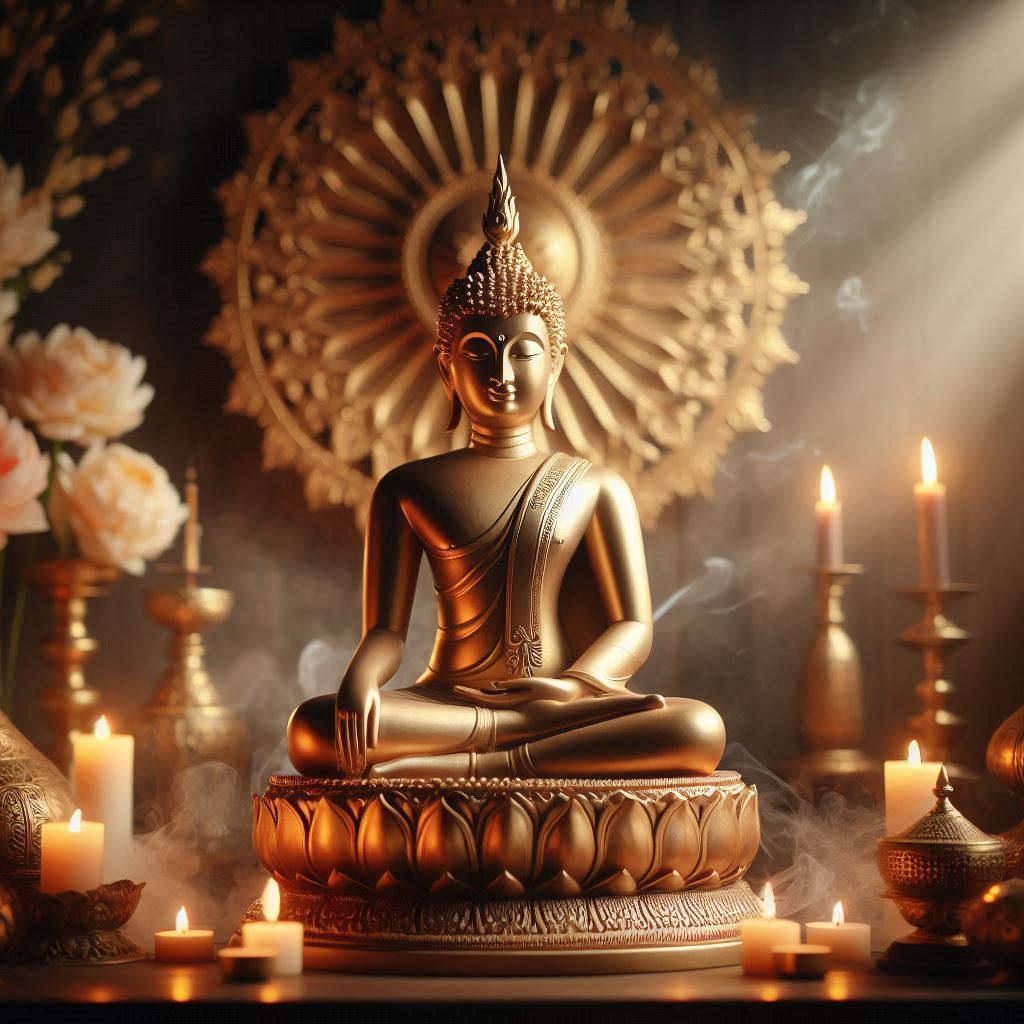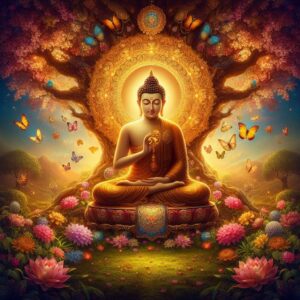🌼 Buddha Purnima 🌼

॥ ॐ श्री परमात्मने नमः ॥
🚩Buddha Purnima 2025 🚩

About Buddha Purnima
On Buddha Purnima, also called Buddha Jayanti, Prince Siddharta Gautama, who would go on to become the Buddha and establish Buddhism, was born. “Purnima” means “full moon” in Sanskrit, and according to Hindu and Buddhist lunar calendars, the festival is observed on a full moon day in the month of “Vaisakhi.” “Jayanti” translates to “birthday.”
The Buddhist holiday of Buddha Purnima is sometimes called Buddha Jayanti or Vesak. The festival, which is observed by the Buddhist community nationwide as well as in nations like Sri Lanka, Indonesia, Malaysia, and others, commemorates the birth, enlightenment, and death of Gautama Buddha. The celebration is highly anticipated and is celebrated with great fervor.
Usually observed on the day of Vesakh’s full moon, the date varies from year to year according to the Gregorian calendar. April or May are usually the months when the celebration takes place. This is due to the fact that the precise date is determined by the lunisolar calendars of Asia. The festival takes place in June if it’s a leap year.
***
🕰️Buddha Purnima 2025 Date & Time:📅
2587th Birth Anniversary of Gautama Buddha
Buddha Purnima – Monday, May 12, 2025
Purnima Tithi Begins – 20:01 on May 11, 2025
Purnima Tithi Ends – 22:25 on May 12, 2025
***
💐About Gautama Buddha: 💐
King Suddhodana gives birth to Gautam Buddha as Siddhartha Gautama. He had an extremely opulent upbringing. The prince was kept apart from the outer world to prevent him from being swayed toward a religious life because it was foretold at birth that he would grow up to be a powerful monarch. But when he was 29, the prince made the decision to travel more and started taking trips in his chariot beyond the palace grounds.
During his travels, he came across a body, an elderly man, and a sick man. His charioteer had to describe the sufferings of aging, illness, and death since Siddhartha Gautama had been shielded from them. He was struck by the monk’s serene manner when he encountered him at the end of the journey. He therefore made the decision to venture out into the world to find out how that man could be so calm in the face of so much sorrow.
He became a nomadic ascetic after leaving the palace. He quickly became an expert in the medical systems of Alara Kalama and Udraka Ramaputra. He experienced intense spiritual realizations, but because he was not content, he set out to find nirvana, the pinnacle of enlightenment. Seeking enlightenment, he took a seat beneath a banyan tree. After achieving enlightenment, he established Buddhism and began teaching about it.
***
🌻Rituals To Celebrate Buddha Purnima: 🌻
- People can visit the Buddha temple on the day of Buddha Purnima, present flowers, recite rhymes, and convey information about the life, teachings, and values of Gautam Buddha.
- Crowds of devotees flock to sacred temples such as the Mahabodhi Temple in Bodh Gaya, the Sarnath Temple in Varanasi, Dhaulagiri in Orissa, and several more. You are therefore welcome to visit these temples and seek blessings on this beautiful day.
- Kindness and nonviolence are among the standards and guidelines that any Buddhist taking part in the event must follow. They have to refrain from eating meat and wear white as a symbol of peace and compassion for the underprivileged.
- Devotees clean and adorn the Lord Buddha sculptures with fresh flowers and water. Devotees also give the less fortunate money, food, and clothing. In some parts of China and Southeast Asia, people also release caged birds or animals to mark auspicious occasions.
- On this auspicious day, people could make delicious delicacies like milk porridge or kheer and give them to loved ones who are less fortunate to spread joy and happiness.
- Many people also use this day to connect with the spiritual heart of Lord Buddha’s teachings through prayer and meditation.
***
🌻 History Of Buddha Purnima: 🌻
Buddha Purnima, which falls during the month of Vaishakha, honors the anniversary of Gautama Buddha’s birth. Buddhism was founded on the teachings of a spiritual master named Siddhartha Gautama, also referred to as Gautama Buddha.
The birth and death dates of Gautama Buddha are uncertain. However, the majority of historians believe that he lived between 563 and 483 B.C. Most people think that Lumbini, Nepal, is where Buddha was born. At the age of 80, Buddha died in Kushinagar, Uttar Pradesh.
For Buddhists, Bodh Gaya is the most important pilgrimage site connected to Gautama Buddha’s life. Sarnath, Lumbini, and Kushinagar are the three other important pilgrimage locations. After becoming enlightened at Bodhgaya, Gautama Buddha is believed to have proclaimed the Dharma for the first time at Sarnath.
Legend has it that Gautama Buddha became enlightened on this day. Buddha Purnima is also known as Buddha Jayanti, Vesak, Vaishaka, or Buddha’s Birthday.
Buddha is considered the ninth incarnation of Lord Vishnu in North India, while Lord Krishna is considered the eighth. However, Buddha is never considered a Vishnu incarnation in South Indian tradition. The southern Indian region considers Krishna to be the ninth incarnation of Lord Vishnu, whereas Balarama is the eighth. Balarama is regarded by the majority of Vaishnava movements as an avatar of Vishnu. Buddhists do not consider Buddha to be an expression of Lord Vishnu.
***
🍀Important Milestones in Early Buddhism:🍀
- 563 B.C.: Prince Siddharta Gautama is born in Lumbini, Nepal. He later becomes known as Buddha, the founder of Buddhism.
- 528 B.C.: Buddha gains enlightenment while meditating under a Bodhi tree in Bodh Gaya, Bihar, India. This event is known as the “Awakening.”
- 483 B.C.: Buddha attains nirvana, the release from the cycle of rebirth, and passes away in a state of deep meditation.
- 269-231 B.C.: During the reign of King Ashoka, a patron of Buddhism, Buddhist evangelism begins and the religion spreads throughout Asia.
***
🌅Significance of Buddha Purnima:🌅
Buddha Purnima is a significant holiday because it honors the life of the Buddha, celebrates his teachings, fosters intercultural understanding, and emphasizes how applicable his ideas are to the present day. The celebration of Buddha Purnima unites Buddhists worldwide in support of a shared interest. It emphasizes the universality of Buddha’s teachings and fosters cultural unification. Buddha Purnima is observed to honor the life of the Buddha, a historical person whose teachings have had a profound influence on society.
It gives Buddhists a chance to consider the lessons taught by the Buddha and their applicability today. The ‘thrice-blessed festival’ is another name for Buddha Purnima, which commemorates the three major moments in the life of the Buddha: his birth, enlightenment, and nirvana. These occasions mark important turning points in the life of the Buddha and encapsulate his core teachings. Buddha’s teachings on discipline, wisdom, and focus are still applicable today, and the festival offers a chance to consider these lessons and how we could use them in our day-to-day lives.
***
🌏The Buddha’s Teachings:🌏
- A day can be changed in an instant, and a life can be changed in a single day. And the world can change in the span of one life. The way to true happiness is to focus on the here and now rather than getting lost in the past or decorating your aspirations for the future.
- According to Lord Buddha, craving is the primary source of suffering. The destruction of craving is the first step toward freedom from the miseries and samsara chakra.
- He advised his disciples to “imbibe my knowledge and follow the path I have been told.” I regularly practice meditation.
- To break free from the circle of life and to end miseries, he advocated adopting the Ashtanga Marg. He highlighted Samyak vision, Samyak Sankalpa, Samyak Vyak, Samyak Karma, Samyak Aajeev, Samyak Karma, Samyak Smriti, and Samyak Samadhi about the Ashtanga Marg.
- The individual on the floor appears exhausted, and the night seems to go on forever, much like it does for many who struggle with insomnia. Likewise, the genuine road leads to an equally lengthy cycle of life and death for materialistic people.
- The ultimate religion, in Gautama Buddha’s opinion, is non-violence. The Yajna involved animal sacrifice, which Gautama Buddha opposed, favoring non-violence instead. Every living thing on earth has the right to live its life, according to Lord Buddha.
- The tongue kills without spilling blood, much like a sharp knife. Speak the truth in gentle tones at all times. Even among clever people, a foolish individual never tests the truth in his life.
- It would be better to conquer oneself than to win hundreds of battles. Then you will always have the victory. Neither a monster nor a god could take it from you.
***
🍀Chanting of Buddha Purnima Mantras:🍀
Triratna (Three Jewels) Mantra
🔸 बुद्धं शरणं गच्छामि।
🔸 धर्मं शरणं गच्छामि।
🔸 संघं शरणं गच्छामि।
Transliteration:
Buddham Sharanam Gacchāmi
Dhammam Sharanam Gacchāmi
Sangham Sharanam Gacchāmi
Meaning:
I take refuge in the Buddha,
I take refuge in the Dharma (his teachings),
I take refuge in the Sangha (the spiritual community).
Buddha Vandana Mantra:
नमो तस्स भगवतो अरहतो सम्मा सम्भुद्धस्स।
Transliteration:
Namo Tassa Bhagavato Arahato Sammā Sambuddhassa
Meaning:
Homage to the Blessed One, the Worthy One, the Perfectly Self-Enlightened One.
***
💐Conclusion💐
The festival of Buddha Purnima commemorates the birth, enlightenment, and demise of Gautama Buddha, the Buddha who founded Buddhism. It encourages people to start their own spiritual journeys by serving as a reminder of the Buddha’s enormous wisdom and compassion. By comprehending the core of Buddha Purnima and considering its importance, we can learn more about the universal lessons the Buddha taught and work to improve both the world and us.
***